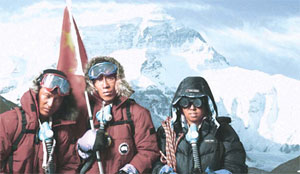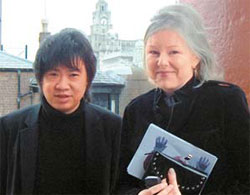Soaring to the summit
8848-1.86, an installation and media by artist Xu Zhen. |
Indeed, there is a growing conviction that it might even surpass the hugely successful exhibition spanning the reigns of the three Qing Dynasty emperors Kangxi (1662-1722), Yongzheng (1723-35) and Qianlong (1735-95), which attracted record visitors to London's Royal Academy of Arts two years ago. While the previous show was devoted to the artistic and cultural riches of Imperial China, this latest offering is a different creature altogether.
Billed as the show of the year if not the century so far at the Tate's northern
Chinese artist Zhou Tiehai with Karen Smith, a British art writer and curator based in Beijing. |
Perhaps the most startling of the exhibits is by Shanghai artist Xu Zhen, who a decade ago was struggling to scratch a living. As part of an artistic "stunt" that outraged many environmentalists, Xu had hacked off the tip of Mount Qomolangma and shipped it back to Beijing where he displayed the frozen lump of rock and ice in a refrigerated box.
This audacious act recorded on video sent shock waves around the globe, yet it persuaded Tate Liverpool's head of exhibitions Simon Groom that he had to involve Xu in the planned exhibition The Real Thing Contemporary Art from China that has taken three years to bring together.
Groom's other great coup was commissioning Ai Weiwei one of China's best-known artistic figures, particularly for his involvement with the "Bird's Nest", the fabulous latticework of girders at the Olympic Stadium in Beijing being built by Herzog and de Meuron.
Ai's contribution to the exhibition which has cost a total of more than 5 million yuan ($645,000) is an 8-meter high floating crystal chandelier of light, weighing 3 tonnes. This astonishing creation called The Fountain of Light is valued at over 1 million yuan ($130,000) yet Simon Groom reveals that sponsorship flowed once the word was out about his ambitious hopes for such an eclectic Chinese focused exhibition.
At the turn of the millennium, China was the star of the Venice Biennale and ever since there has been a surge of exhibitions from New York and Berlin to London and Sydney.
Groom insists that the Chinese art scene is quite amazing at present. "It is just simply NOW!" he exclaims.
"The price of contemporary Chinese art has made it probably the most sought after and costly in the world. There is so much interest in China at present that people are falling over themselves to get a share of it."
Indeed he has the backing of the Henry Moore Foundation and the UK Red Mansion Foundation amongst a string of well-heeled patrons that are clearly aware of the exhibition's importance. China's cultural counsellor from the embassy in London, Ke Yasha, attended the launch party.
Apart from Xu Zhen, who as well as participating was an adviser to the project, Groom also worked closely with the British art writer and curator Karen Smith based in Beijing. She writes for Time Out as an art critic and last year published her first book on Chinese art Nine Lives: The Birth of Avant-Garde Art in New China that explored the emerging art scene.
A fluent Mandarin speaker, Smith has lived in China since the early 1990s and introduced Groom to many of the new wave of Chinese artists in Beijing, particularly those based in the Dashanzi arts community located in a former machine tool plant known as Factory 798, and the even more dynamic Alcohol Factory.
"There is a different official attitude to art these days and we were able to talk to a lot of artists and curators in China," she says. "We wanted this exhibition to reflect what is really happening today and so we came up with the title The Real Thing."
Groom continued: "It is a true indicator of contemporary art in China at present, characterized by humor and irony."
Other artists chosen for the British show include Wang Peng whose humorous videos reflect on travel; Gu Dexin who deals in mixed media; Yang Fudong whose 840,000 yuan ($108,000) video installation is called Dog 2007; as well as Qui Xiaofei, Gu Dexin and Yang Shaobin whose oil paintings of miners at work are courtesy of the Long March Foundation.
While reaction to the exhibits has been mostly positive, some more conservative minded visitors were cautious.
The UK based writer and exhibition organizer Xia Lu originally from Beijing remarked: "Maybe this doesn't reflect the real traditional quality of Chinese art. I think maybe it is not as clever as some suggest."
Yet her British colleague Dave Ward who has recently completed a short literary lecture tour of China thought it a fantastic example of how China is developing.
Other Chinese visitors to the Tate exhibition a little more mature in years also expressed a view that it was perhaps more Western influenced than they might prefer. And veteran China hand Kerry Brown who heads up the British based Strategic China consultancy and a committee member of the distinguished 48 Group Club involved with China since the early 1950s commented: "It is certainly different and while maybe not my cup of tea, I admire the energy that has gone into it.
The show continues until June 10 and is running in tandem with the UK focused Aftershock exhibition in Beijing's Capital Museum. Sponsored by the British Council, it features the "brat-pack" of British artists such as Damien Hirst and Tracey Emin.
The author is editor-in-chief of Cities500 International Publishers
(China Daily 04/17/2007 page19)
















